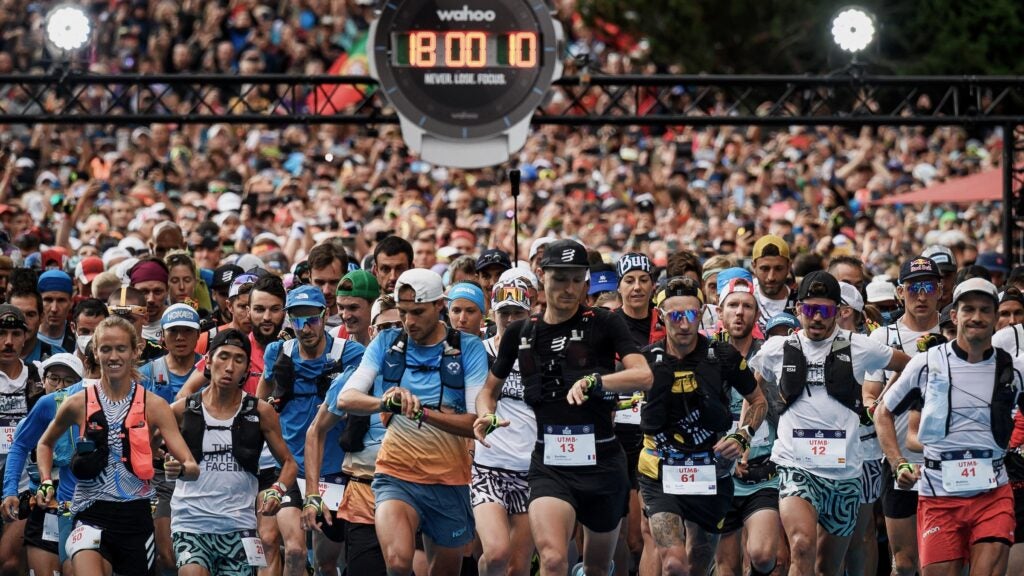No products in the cart.
Outdoor Adventure
What Strava Data Tells Us About How Runners Train for UTMB
UTMB, or the Ultra-Trail du Mont-Blanc, is a 106-mile loop around the Mont Blanc massif with over 32,940 feet of elevation gain. This mountain ultra attracts some of the top competition in the world, drawing in names like Kilian Jornet and Courtney Dauwalter, while hosting thousands of runners from all over the world.
Runners must accumulate qualifying points via “stones” in UTMB-branded events of comparable distances in the UTMB World Series. For example, runners who want to run the 106-mile race in Chamonix must finish a UTMB event like Canyons by UTMB or Wildstrubel by UTMB. So, by the time many runners toe the line in Chamonix, they have some experience in the distance.
In 2022, 68 percent of the 2,300-plus runners finished UTMB. How do these runners train for such a beastly race? We parsed through the Strava data for some surprising finds.
How UTMB Runners Train
After analyzing Strava data from UTMB runners, there was not a statistically significant difference in training between finishers and non-finishers, who were nearly identical across all measures including training volume, vertical feet accumulated, and median longest run. A 68 percent finishing rate for UTMB is fairly respectable among mountain ultras. For comparison, the Western States Endurance Run’s (WSER) finishing rate in 2023 was 81 percent, versus the 2023 Leadville 100’s 43 percent finishing rate, likely due to the absence of a qualification process and coupled with extreme altitude and this year’s hot conditions.
Over six months of training, UTMB runners average 931 cumulative miles, 140 hours of running time, and more than 130,000 feet of elevation gain. That averages out to 38 miles per week, or just under six hours a week of running over a 24-week training cycle. The average UTMB runner starts at a 30-mile-a-week average, which they build towards nearly 80 miles a week in their peak week.
RELATED: 10 Things to Know About Jim Walmsley’s Obsession to Win UTMB
The peak week for most runners is three weeks before race day, and the data shows a wide range in UTMB runners’ peak weeks. The average sits at just 79 miles in that peak week, but the majority of athletes fall somewhere between 66 to 97 miles in that high volume week.
On average, UTMB runners rack up 16,000 of elevation gain in their peak week. Diving into 2022’s UTMB men’s winner Kilian Jonet’s training data from last year, we can see that even while recovering from a win at the Hardrock 100, Jornet mimicked the average elevation gain of UTMB in his training, logging runs that average between 396-750 feet per mile.
Long runs are also essential to prepare for an event like UTMB, and many athletes used a race to facilitate the build towards race day. Strava revealed that 57 percent of runners did a race in their training, while 39 percent of UTMB runners’ longest run was 100K or longer. Also, 62 percent of athletes logged a long run of over 50 miles.

Long runs like these were infrequent in UTMB runners’ training. Twenty-four percent of UTMB runners did more than one run of 50 miles or longer. In fact, when you control for these very long runs and races in UTMB runners’ training, the median long run in the two months leading up to the race is just 14 miles. Additionally, the median number of weeks an athlete logs a run of 20 miles or longer is six.
That’s generally in alignment with recommendations for 100-mile training, which are trending towards not overemphasizing the long run which risks injury, and has diminishing returns for adaptation. For example, while the exact data isn’t public, Courtney Dauwalter says her long runs training for UTMB in 2022 were typically between three or four hours, seeing that the cost of going over five hours outweighed the potential benefits.
UTMB Versus Western States
When comparing how athletes trained for the Western States Endurance Run with UTMB, interesting trends emerge. First, let’s acknowledge the obvious: these are very different events on almost every front, but this can still offer important comparisons.
WSER is a significantly less technical race, traversing from Olympic Valley to Auburn, California, on terrain that is much less steep than the European Alps. It’s also significantly hotter, though 2023 was a particularly cool year (a factor in this year’s somewhat anomalously high finishing rate of 81 percent). The field is also smaller, with just under 400 runners, versus UTMB’s 2,400 runners. They both have qualifying standards that mandate runners have experience at a similar distance—a minimum of 100K for WSER runners.
RELATED: Here’s What Strava Data Says About Your New Year’s Resolution
Finishing times and cutoffs are also different. Dauwalter, who currently holds the women’s record on both courses, demonstrates the difference in difficulty. Her course record for WSER is a blistering 15:29:33, while her equally impressive UTMB course record is 22:30:54.
Most UTMB runners take between 32 and 46 hours to finish, with the average finishing time being about 40 hours. The cutoff times for the courses are also very different, with WSER’s 30-hour cutoff being in step with the relatively tame terrain, but also significant enough to confer an honor to all belt buckle recipients.
UTMB, on the other hand, has a cutoff time of 46.5 hours, which reflects the difficulty of the terrain and the difference between European and U.S.-based trail racing. When runners receive their bibs for UTMB, they also get a paper card that says “Sleeping, Do Not Disturb” due to anticipating the prevalence of napping on the course.
UTMB runners logged less volume than WSER runners, averaging just 38 miles a week compared to WSER’s 50 average weekly miles. UTMB runners, however, packed a lot of vert into those miles, averaging 140 feet per mile over the training cycle, versus WSER’s 115 feet. This means that UTMB runners’ training was 22 percent steeper than that of WSER runners. This makes sense as UTMB is significantly steeper, racking up almost double WSER’s 15,540 total feet of elevation gain.
UTMB runners logged significantly less distance than their WSER counterparts, averaging just 931 miles over the six-month training cycle, versus 1,193 miles for WSER. Western States runners’ peak weeks were bigger, too, averaging 87 miles in their highest volume week, versus UTMB’s 79 miles.
The clear trend that emerged from UTMB runners’ data is that you might not need to run as much as one might think to be successful at this event. Starting at 30 miles a week, and peaking at below 80 is achievable for many runners, which is perhaps what makes this extreme, but attainable, event so alluring for runners all over the world.
Source link

